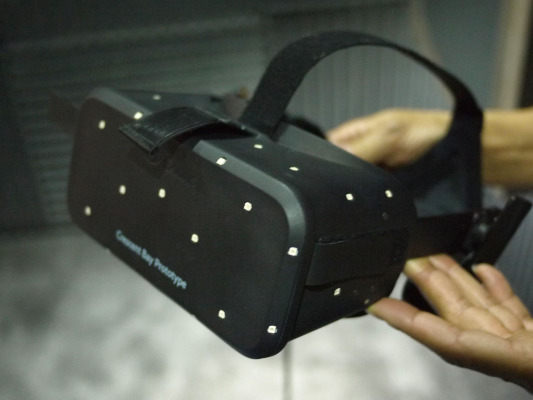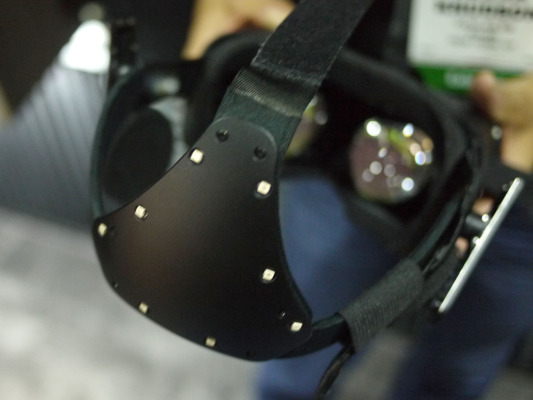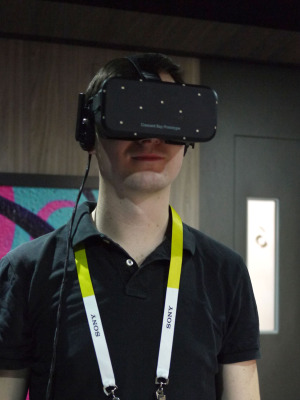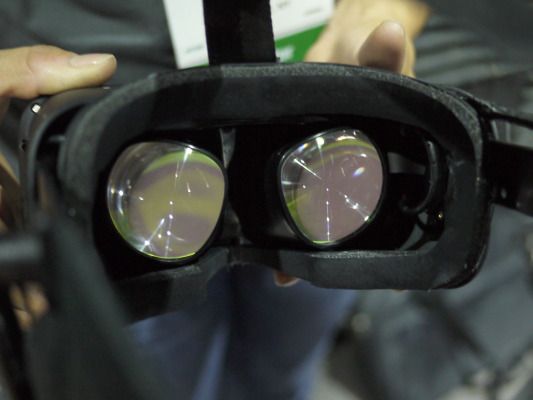Oculus Rift Crescent Bay Hands On
The Oculus Rift Crescent Bay is the latest iteratoin of Ocurlus VR’s virtual reality headset technology. As well as head movement tracking and 3D vision it adds integrated surround audio and head position tracking. We got hands on at CES 2014 to see how it compares to previous versions.
Pros
- Overall sense of 3D and immersion is stunning
- As flawless movement tracking as ever
- Positional tracking is excellent
- Virtual surround sound adds to the experience
- New rigid headband is easier to handle
Cons
- Still doesn’t have high enough resolution to eliminate graininess
- Field of view is still a little narrow
- Yet to make it all that comfortable when wearing glasses
Oculus Rift Crescent Bat – Design and Comfort
The most obvious upgrade with the Crescent Bay is its new headband design. It now uses a largely rigid strap system, with hard plastic section at the back that also includes some motion tracking dots – more on which later. As well as allowing for the addition of these dots, the rigid headbands also provide somewhere for the fold up/down integrated headphones to mount.
Despite all this rigidity, the headset is still quite comfortable. It’s easy to adjust via the top and side velcro straps and after just a few moments we had a secure and largely comfortable fit. It’s not all that accommodating of glasses, especially due to pressure from the sides, but we still managed to enjoy the experience even with the rough fit we’d achieved.
Although lighter than previous versions of Oculus Rift, Crescent Bay is still a fairly weighty thing, with the front obviously holding most of the bulk. Given the slightly awkward fit due to our glasses, and only having limited time to adjust it, we did find ourselves having to support the front quite often, but we’re sure this could be resolved with more time to find a better fit.
Oculus Rift Crescent Bay – Movement Tracking
The key new addition for Crescent Bay is the addition of motion tracking. Where previous headsets could detect which way you were facing – up, down, left, right, tilt left, tilt right – they couldn’t tell where your head was within a 3D space. With Crescent Bay Oculus VR has added traditional movie motion capture-style motion tracking, with white dots covering the front and back of the headset.
Coupled with cameras that track these dots Crescent Bay allows you to actually move within the VR space of the Rift. So you can duck and jump, strafe or step forward and back.
Oculus VR used this latter ability to great effect in its demo rooms – which were kitted out with slightly raised platforms to stand on so you could tell where you were before hitting the wall – by having one scene where you’re on a ledge at the top of a really tall building (it was possibly somewhere famous but I didn’t pick it out). With the tracking it was able to sense you walking towards the edge, and as someone that is afraid of heights I can assure you it’s pretty bloody effective!
The Unreal engine demo that’s been doing the rounds – the slow mo one with the screaming robot at the end – is given an extra dimension to as you can duck and strafe out the way of the oncoming bullets. Similarly, a maruading Tyrannosaurus Rex that steps over you tests you ability to get yourself in just the right spot.
Of course the big disadvantage of this new technology is that it requires motion tracking cameras and for the user to stand up. As such Oculus has stated that it doesn’t see this being the future of most home-user VR and it is mainly just testing what can be done for now. Still it’s possible that a basic version of the technology could be used to track basic leaning movements when sat at a PC – could be great for looking round corners in FPS games for instance.
Oculus Rift Crescent Bay – New optics
Oculus VR hasn’t stated the resolution of the latest headset but we do know that both the display and the optics have been upgraded. The former has indeed had a resolution boost and it’s now running at a higher framerate of 90fps, which further reduces blur and crosstalk.
As for the optics, Oculus has added an extra layer that slightly merges the pixels of the display to reduce the obviousness of the pixels. Otherwise, though, it hasn’t stated exactly what other changes it has made.
Overall the affect of these upgrades was a little underwhelming, without having a DK2 headset on hand to directly compare. The key problem being you could still quite clearly see the pixels. Even if it is an upgrade, it’s didn’t feel like enough of one to really convince us.
It’s a bit like the incremental resolution increases that were happening on phones then suddenly Apple came along with its Retina Display and it felt like a step change. With Crescent Bay that step change hasn’t happened and we’re still moving in increments. We’re sure it won’t be long before that big step occurs, though.
Oculus Rift Crescent Bay – Surround Sound
One of the best additions to Crescent Bay is its integrated surrounds audio. While virtual surround sound is nothing new, and you could just as easily use your own headset, the ease of just being able to flip down the earpieces is definitely welcome. What’s more sound quality is good and the integration with the visual 3D effect is spot on.
Virtual surround isn’t perfect but it most definitely adds to the experience. We’d certainly like to see it integrated into the next commercially available kit.
Oculus Rift Crescent Bay – Early Verdict
From our brief demo, Crescent Bay doesn’t appear to be the big upgrade many DK2 owners may have been hoping, particularly in terms of image quality. The faster framerate helps retain clarity when fast movement is involved but the resolution still needs a more significant boost.
As for the motion tracking, while it’s academically quite interesting, in it’s current form it’s impractical for most home users, so we’d hope to see a simpler ‘desktop’ version.
We’re definitely onboard with teh virtual surround sound, though. It would probably be good to have it be optional, for those users that already have a surround headset (and assuming the software supports use of other headsets) but there’s no doubt it improves the experience greatly.
Crescent Bay has been out for nearly 5 months now so here’s hoping it won’t be too long before a DK3 kit based on it is commercially available, hopefully with an uprated display!





